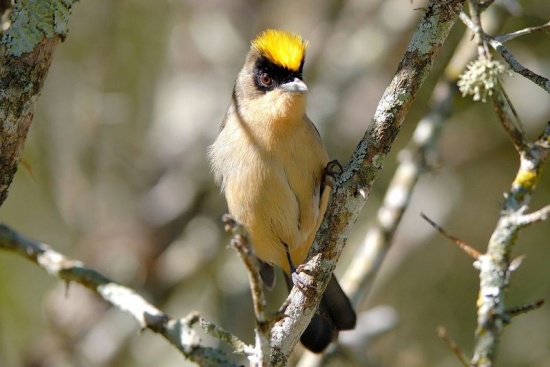(change photo & add info template) |
(→External Links: Multiple GSearches combined) |
||
| (14 intermediate revisions by 8 users not shown) | |||
| Line 1: | Line 1: | ||
| − | + | [[Image:Black-goggled_Tanager2.jpg|thumb|550px|right|Male<br />Photo © by {{user|Luiz|Luiz}}<br /> Itatiaia Park Hotel, Rio de Janiero, [[Brazil]], May 2007]] | |
| − | [[Image:Black-goggled_Tanager2.jpg|thumb|550px|right|Photo by Luiz<br/> | + | ;[[:category:Trichothraupis|Trichothraupis]] melanops |
==Identification== | ==Identification== | ||
| + | 16 cm (6¼ in) | ||
| + | [[Image:Tie-de-topete1.jpg|thumb|350px|right|Female<br />Photo © by {{user|Xyko+Paludo|Xyko Paludo}}<br />Pilarzinho, Curitiba, PR, [[Brazil]], July 2018]] | ||
| + | *Tawny underparts | ||
| + | *Dull brownish-olive back and head | ||
| + | *Black tail and wings | ||
| + | *White [[Topography#Wings|speculum]]<br /> | ||
| + | ''' Male''' | ||
| + | *Yellow crown patch (not always obvious) | ||
| + | *Large black patch around the eyes (giving the species its name)<br /> | ||
| + | '''Female''' - similar but lacks the black goggles and the yellow crest. | ||
==Distribution== | ==Distribution== | ||
| + | [[Image:44584tiedetopete.jpg|thumb|350px|right|Male<br />Photo © by '''[http://www.birdforum.net/member.php?u=44584 Rogerio Araújo Dias]'''<br /> Brasilia, [[Brazil]]]] | ||
| + | [[South America]]: found in eastern and southern [[Brazil]], eastern [[Paraguay]] and north-eastern [[Argentina]] with a separate population in [[Peru]], [[Bolivia]] and north-western [[Argentina]].<br /> | ||
| + | Uncommon to fairly common. Andean population uncommon and local. | ||
==Taxonomy== | ==Taxonomy== | ||
| + | This is a [[Dictionary_M-O#M|monotypic]] species<sup>[[#References|[1]]]</sup>. | ||
| + | |||
==Habitat== | ==Habitat== | ||
| + | Low level rain forest, forest edges and woodland.<br /> | ||
| + | Occurs at 1000 - 1700m in the Andes (but much lower in [[Bolivia]]). | ||
==Behaviour== | ==Behaviour== | ||
| + | Usually in pairs or small groups, often in mixed-species flocks. An active and restless species.<br /> | ||
| + | ====Diet==== | ||
| + | Feeds on beetles, fruit, seeds and pieces of snail shell.<br /> | ||
| + | ====Breeding==== | ||
| + | Breeding recorded in October and November. The nest was a cup 1m up in bamboo and contained 3 young. | ||
| + | ====Movements==== | ||
| + | A resident species. | ||
| + | ==References== | ||
| + | #{{Ref-Clements6thAug18}}#{{Ref-HBWVol16}}#Ber van Perlo. 2009. A field guide to the Birds of Brazil. Oxford University Press, New York, NY, USA. ISBN 978-0-19-530155-7 | ||
| + | #Ridgely and Tudor 2009. Field guide to the songbirds of South America - the passerines. University of Texas Press, Austin, TX, USA. ISBN 978-0-292-71979-8 | ||
| + | #Wikipedia | ||
| + | #BF Member observations | ||
| + | {{ref}} | ||
| + | ==External Links== | ||
| + | {{GSearch|"Trichothraupis melanops" {{!}} "Black-goggled Tanager"}} | ||
| + | {{GS-checked}} | ||
| + | <br /> | ||
| + | <br /> | ||
| − | + | [[Category:Birds]] [[Category:Trichothraupis]] | |
| − | |||
| − | [[Category:Birds]] [[Category: | ||
Latest revision as of 19:58, 3 January 2023
- Trichothraupis melanops
Identification
16 cm (6¼ in)
- Tawny underparts
- Dull brownish-olive back and head
- Black tail and wings
- White speculum
Male
- Yellow crown patch (not always obvious)
- Large black patch around the eyes (giving the species its name)
Female - similar but lacks the black goggles and the yellow crest.
Distribution
South America: found in eastern and southern Brazil, eastern Paraguay and north-eastern Argentina with a separate population in Peru, Bolivia and north-western Argentina.
Uncommon to fairly common. Andean population uncommon and local.
Taxonomy
This is a monotypic species[1].
Habitat
Low level rain forest, forest edges and woodland.
Occurs at 1000 - 1700m in the Andes (but much lower in Bolivia).
Behaviour
Usually in pairs or small groups, often in mixed-species flocks. An active and restless species.
Diet
Feeds on beetles, fruit, seeds and pieces of snail shell.
Breeding
Breeding recorded in October and November. The nest was a cup 1m up in bamboo and contained 3 young.
Movements
A resident species.
References
- Clements, J. F., T. S. Schulenberg, M. J. Iliff, D. Roberson, T. A. Fredericks, B. L. Sullivan, and C. L. Wood. 2018. The eBird/Clements checklist of birds of the world: v2018. Downloaded from http://www.birds.cornell.edu/clementschecklist/download/
- Del Hoyo, J, A Elliott, and D Christie, eds. 2011. Handbook of the Birds of the World. Volume 16: Tanagers to New World Blackbirds. Barcelona: Lynx Edicions. ISBN 978-8496553781
- Ber van Perlo. 2009. A field guide to the Birds of Brazil. Oxford University Press, New York, NY, USA. ISBN 978-0-19-530155-7
- Ridgely and Tudor 2009. Field guide to the songbirds of South America - the passerines. University of Texas Press, Austin, TX, USA. ISBN 978-0-292-71979-8
- Wikipedia
- BF Member observations
Recommended Citation
- BirdForum Opus contributors. (2024) Black-goggled Tanager. In: BirdForum, the forum for wild birds and birding. Retrieved 31 October 2024 from https://www.birdforum.net/opus/Black-goggled_Tanager
External Links
GSearch checked for 2020 platform.






